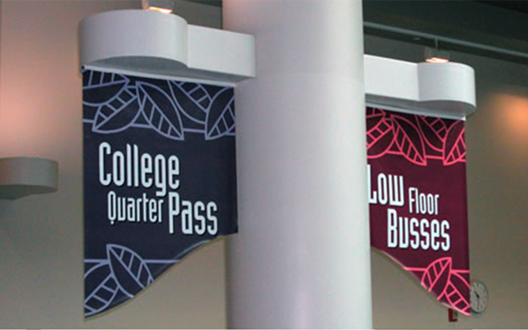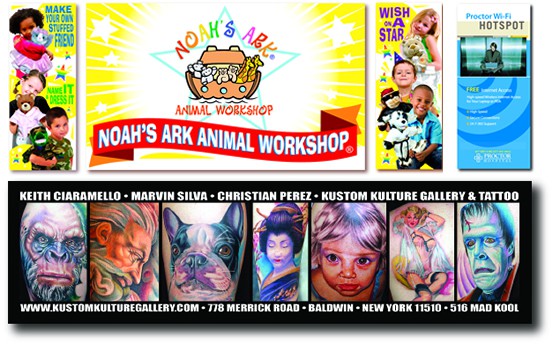Wholesale Heavy Knit Dye Sublimation Fabric Banners for Trade Shows, Resellers, or Brokers
Dye sublimation Polyester Fabric/Cloth Banners are printed on our 9 oz. heavy knit fabric. This 100% polyester sublimation banner fabric is wrinkle resistant and moderately opaque. And no, it doesn’t look like a ’70’s polyester disco suit!
What is Dye Sublimation Printing
Dye sublimation printing is a heat-transfer process, whereby a graphic is printed in reverse on a special transfer paper and heat-transferred while applying high pressure to a polyester fabric, which is the best fabric for sublimation printing. After the paper is printed, the ink/paper is heated to 400+ degrees and using pressure on the paper/ink/fabric, the ink turns into a gas and “sublimates” itself into the fabric – hence the term dye sublimation.
Compared to direct solvent print to fabric, the dye sublimation fabric printing process provides more vibrant colors and a photo-clear definition. Another advantage of this fabric banner printing is that these sublimation banner fabrics are machine washable on a gentle cycle with mild detergent. You can’t do this with solvent-printed fabrics.
Product Features and Options
 Dye Sublimation Fabric Printing on Heavy Knit Fabric Banner Material is available with the following options:
Dye Sublimation Fabric Printing on Heavy Knit Fabric Banner Material is available with the following options:
- FREE set-up on most banner printing
- Hot knife edge-finishing
- Hems and/or Grommets
- Pole Pockets
- Hem Reinforcing
- Design Services
- Ship in approx. 3 to 5 working days
- Rush Orders & Expedited Shipping
- Note: We cannot guarantee exact color matching for all Pantone™ colors
Where to Use Heavy Knit Fabric Banners
Sublimation Printing of 9oz. Polyester Fabric Banners are mainly used for:
- Trade Show Displays
- Convention Hall Banners
- Interior P.O.P. Displays
- Backdrops
- …and more!
Testimonial
OMG The banners came out FANTASTIC!!! I just can’t get over the color on them and how nice they look… Big kudos to you and your team! Please pass along how happy I am! :) Thank you again SO much…I’m already happily planning next year’s order ( but hopefully we won’t have to rush you next time lol).
– Kellee at KelleeArt Design, FL

Get a Quote Now!
Visigraph is a wholesale domestic and import broker, and therefore, we require a minimum order of $500USD for ALL wholesale orders.
All fields marked with star (*) are required.
Large Quantity Quotations
If you need large quantities of dye sublimation heavy knit fabric banners, call us at 509-483-8000, email our sales department directly at sales@visigraph.com, or fill out our Get A Quote form.
The Visigraph 100% Satisfaction Guarantee
We pay careful attention to every detail on every order we receive, and our 100% Satisfaction Guarantee is just what it says…you’ll love our polyester fabric banners or we’ll re-do them. It doesn’t happen often, but hey, we’re human too! Rest assured, though, that if it does, we’ll fix’em free of charge and with no hassle.
Calculating the Size of your Heavy Knit Fabric Banner
Height x Width = Number of Square Feet. For example, if you have a banner that is 5ft. x 5ft.- 5 x 5 = 25 square feet

Polyester Fabric Banner
Another polymer-based banner material is polyester, which is a woven fabric. It is the same type of material that your granddaddy used to wear suits made of. Although, improvements have been made to the materials so that now you can get anything from smooth poly knits to poly silks, poly flags, and sheer fabrics for almost any event, indoor or out.
Polyester fabric is very stain resistant, and only certain specialty dyes are able to permanently color the fabric. It has been made to mirror natural fibers. Poly knits have been used for 50+ years, but now can emulate cotton or wool or taffeta or other natural or synthetic fibers, often with superior durability.
Natural fibers cannot be used in the print process due to their cellular structure and the chemistry of dye sublimation. During the printing process, the pores of the polyolefin fabric expand and open, the dyes are infused, and then the pores close.
Dye Sublimation Printing
Most dye sublimation printers use CMYO printing colors (Cyan-Magenta-Yellow-Overcoating) which is different from inkjet banner printing (on vinyl or fabric) which uses CMYK (cyan-magenta-yellow-black) because the black is eliminated and the clear overcoat is used instead. This overprint is both a UV protectant and helps to create a water-resistant coating for polyester banners.
Dye sub printing is done two different ways. The first way is to print a paper transfer material with CMYO. Once the paper is printed, it is “married” to a cloth banner and is pressure-rolled using heated rollers (at 400F) to sublimate the print to the fabric. The process uses heat and pressure which open the pores or cells of the poly-fabric open up, while simultaneously the dye on the paper is converted to a gaseous state. The gas impregnates the open cells which close as they leave the heated rollers. This creates a continuous tone print which cannot be achieved using an inkjet printer because of the dot pattern laid down by the inkjets.
Sublimation simply means that the dyes convert from a solid state to a gaseous state, although never becoming liquid. The process was developed to be able to transfer photographs and highly intricate designs onto fabric or cloth.
Advantages of Dye Sub Fabric Banners
The dye sub print process permanently infuses the poly fabric with color during the print process so that you can send these banners through the washer without color loss, and a rain storm would be more gentle than your average washing machine.
Other advantages include – the images don’t peel or fade (permanency), the colors can be brilliant due to the amalgamation of the dye to the fibers of the polyester or other synthetic fabric.
Unlike other types of screen and digital printing, dye sublimation use a dot pattern to create color, whereas dye sublimation cloth printing has a continuous tone, just like pictures that you get developed from your camera.
Note that if you use fabric banners or graphics for your booth, you will be separating yourself from the competition who may be using cheaper graphics, thus making themselves look cheap. No one wants a cheap company – just a cheap price with great services or products.
Banner Care
If the banners are small enough to fit in a washer, and I didn’t mention that a rotary washer is superior to an agitator-type washer, then this will be the easiest way to wash your banners. It is likely you’ll need to use a more aggressive grease removing detergent with an outdoor banner that you would with its indoor banner counterpart.
After washing, the best practice is to hang them up to dry. If you don’t have this option, and they’ll fit in a dryer, go ahead and dry them that way. Make sure you don’t leave them in the dryer once it stops, as it’ll create wrinkly banners.
Banner Durability
A flag on a pole, like a country or state flag, has an average life of 6 to 12 months. A banner flag tacked to a wall may last years, though, as the wind will have little affect. On the north side of a building, this banner may last five or ten years. On the south side, west side, or east side, the sun will reduce that banner flag’s longevity, maybe up to 50% or more.
The sun should not be a major concern unless you plan to hang your banner out of doors for multiple years, which is not the norm with most banners anyway. Banners are most often seen as temporary signage, particularly vinyl banners. Fabric banners are used indoors more often than out-of-doors, so they will have less UV damage regardless.
There is not much you can do to protect a banner from the sun, but a good quality ink should keep them lasting as long as you’ll need them to advertise your company or event.
Most digitally printed banners, though, should, if properly installed, last at least 3 years outdoors. I’ve seen wind destroy a poorly installed banner in a period of a couple days, but I’ve also seen a well-installed vinyl banner last over 10 years. The former banner was hung between a couple poles just in time for one of our local wind storms that happen periodically.
Popular Posts Related to the Products:


